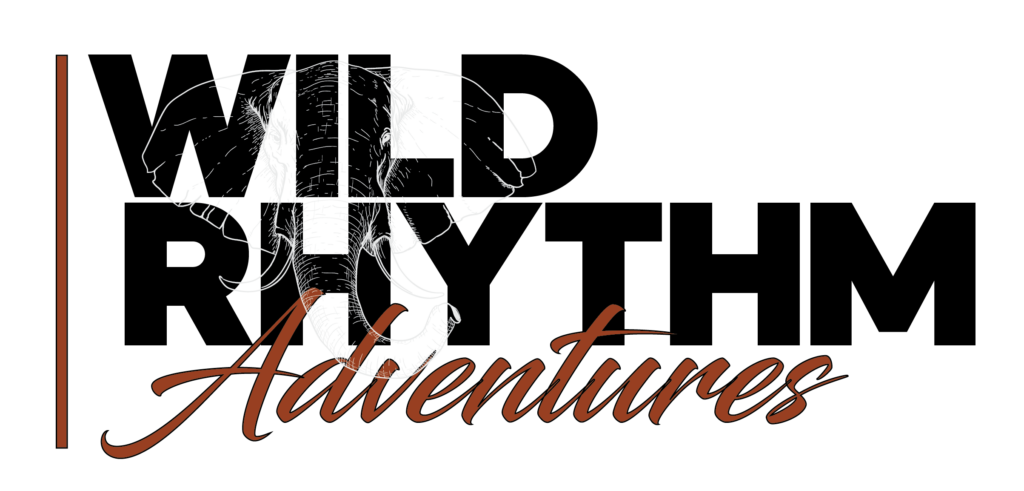- Moshi - Tanzania
- +255 744 916 820
- info@wildrhythmadventures.com
Menu
Mountain Climbing
- Kilimanjaro Climbing
- Mt Meru Climbing
- Ol doinyo lengai
- Zanzibar Vacation
Mount Kilimanjaro stands at 5,895 meters (19,341 feet) above sea level, making it the highest free-standing mountain in the world and known as the “Roof of Africa.”
It’s one of Africa’s top travel destinations, attracting over 40,000 visitors each year. The climb offers stunning views, and you don’t need any technical climbing skills. All you need is a good level of fitness to reach the summit.
We’ve created this guide to help you get ready for your unforgettable Kilimanjaro adventure. The advice here comes from our 5+ years of experience with Kilimanjaro climbs. At Wild Rhythm Adventures, we’ve helped over 500 people successfully reach the top.
The Marangu Route is the only route with hut accommodations, making it more comfortable compared to camping. It’s one of the most popular and easiest routes, but it also has a higher success rate due to its shorter trek. The route starts and ends at the same point, and the path is well-established, with a steady ascent. However, the shorter acclimatization period makes it harder for some climbers to adjust to the altitude.

Known for its stunning views and diverse landscapes, the Machame Route is one of the most scenic and popular routes. It takes you through rainforests, moorlands, and alpine deserts, providing a variety of environments. The route is more challenging than Marangu, as it involves camping and longer trekking days, but it allows for better acclimatization due to the “climb high, sleep low” approach.
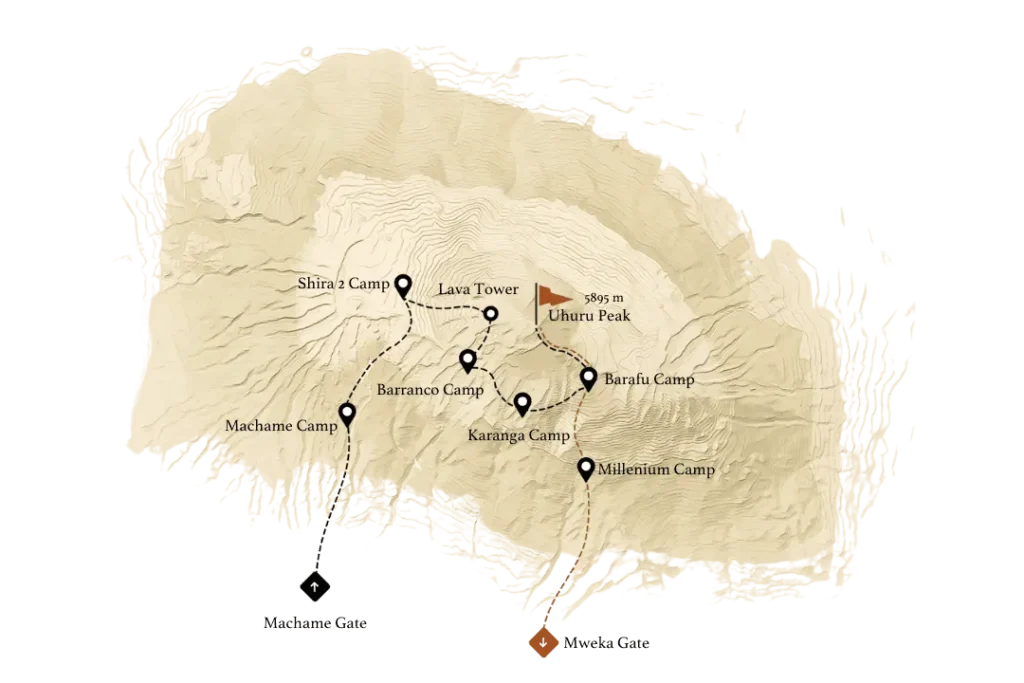
The Lemosho Route is one of the most scenic and least crowded routes. Starting on the western side of the mountain, it provides a gradual ascent, which helps with acclimatization. The route is longer than Machame, but this gives you more time to adjust to the altitude, leading to a higher success rate. It also offers beautiful views and a variety of landscapes.
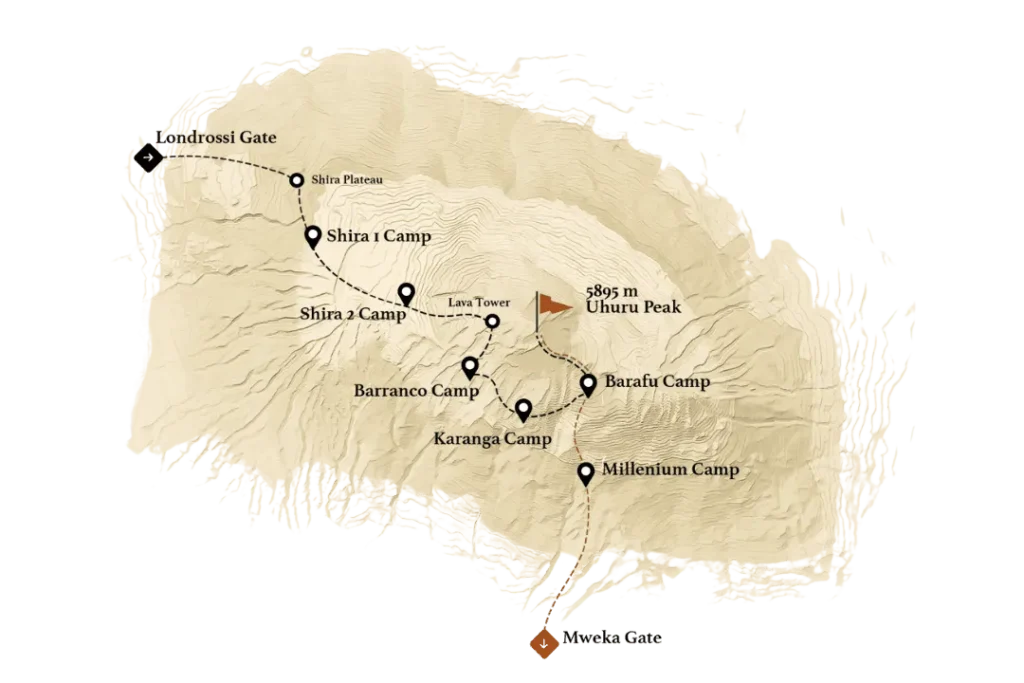
The Rongai Route is the only route that starts from the northern side of Kilimanjaro, near the Kenyan border. It is considered one of the easier routes because it has a gradual ascent and is less crowded. The route has beautiful views and takes you through dry, forested areas and moorlands. However, it’s not as scenic as some of the other routes.

The Umbwe Route is one of the steepest and most difficult routes, recommended only for experienced trekkers. It’s not ideal for beginners due to its quick ascent and challenging terrain. Although it’s a short route, the difficulty can make it more dangerous, especially if acclimatization is not managed properly.
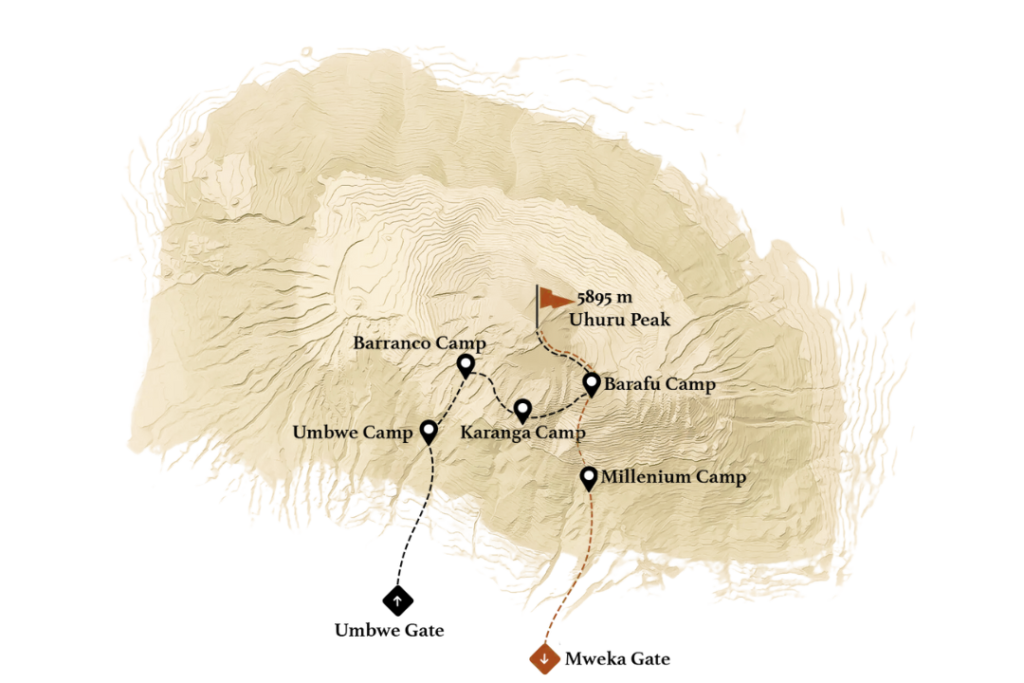
The Northern Circuit is the newest and longest route, offering a unique experience of the mountain’s northern slopes. It’s one of the most scenic and least crowded routes. The longer duration allows for better acclimatization, improving your chances of summiting successfully. It’s a relatively quiet route, with stunning views and diverse landscapes.
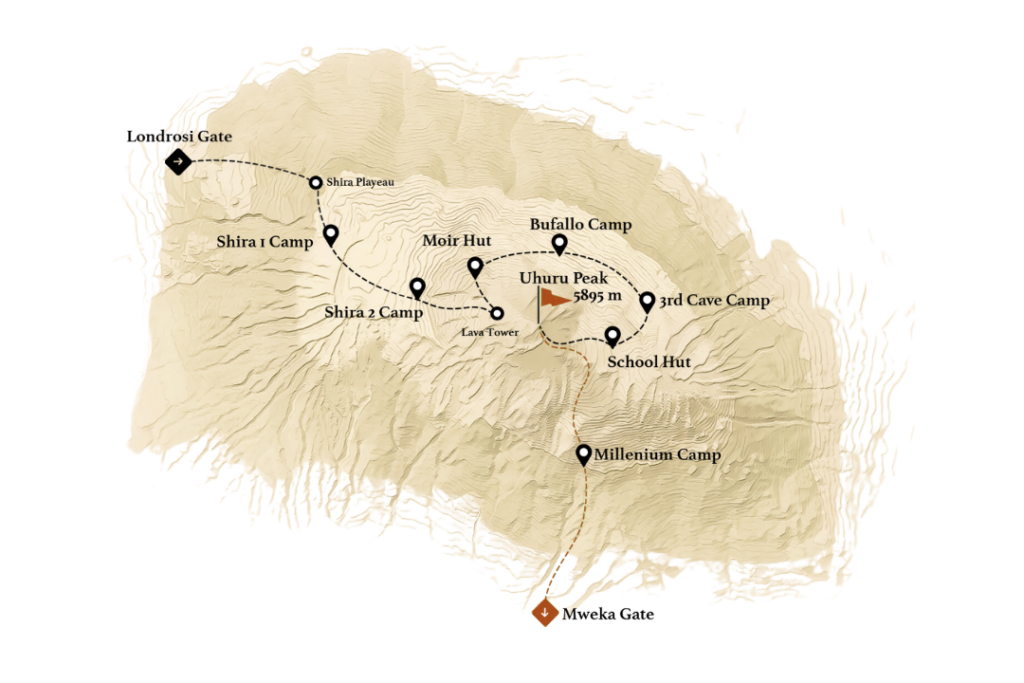
The Shira Route is similar to the Lemosho Route but begins at a higher elevation. This longer route provides more time for acclimatization, helping climbers adjust to the altitude gradually. The terrain is diverse, offering stunning views of Kilimanjaro’s summit and the surrounding landscapes. However, starting at a higher altitude can make it more challenging for climbers who are not well-prepared for high elevations.

The Mweka Route begins at the summit of Kilimanjaro (Uhuru Peak) and descends through the alpine desert and rainforest zones. It is a direct, well-maintained path that allows climbers to descend quickly and safely.
As a descent route, the Mweka Route is generally easier than most ascent routes. However, it is still important to be cautious because of steep sections and the potential for fatigue after summiting the mountain.

Mount Kilimanjaro can be climbed year-round, but the best times are during the dry seasons — January to March and June to October. These months offer more stable weather, clearer skies, and lower chances of rain, making for a safer and more enjoyable trek. January to March is generally colder but quieter, while June to October sees more climbers and warmer weather. Planning around these windows greatly increases your chances of a successful and comfortable summit.
No technical climbing experience is necessary to reach the summit of Mount Kilimanjaro. It’s a high-altitude trekking expedition, not a technical climb, meaning you won’t need ropes, crampons, or climbing gear. However, the altitude, physical endurance, and mental resilience required make it a real challenge. Anyone in good physical condition with strong determination can successfully climb Kilimanjaro — especially with proper preparation and a guided team supporting you.
The duration of a Kilimanjaro climb depends on the route you choose, ranging from 5 to 9 days. Shorter climbs may seem tempting, but they offer limited time for your body to adjust to altitude, which reduces your chances of reaching the summit. Most climbers opt for a 7 or 8-day trek, which allows for better acclimatization, a more relaxed pace, and a significantly higher summit success rate. Our itineraries are designed to balance safety, comfort, and success.
Success rates vary by route and duration. Climbs of 7 days or more have a success rate of 85–95%, largely due to better acclimatization and a more gradual ascent.
Yes, altitude sickness is the most significant challenge on Kilimanjaro — not the trail or terrain. As you ascend, the oxygen levels decrease, and your body needs time to adjust. Symptoms can include headaches, nausea, dizziness, or fatigue. Our guides are trained in altitude awareness and carry pulse oximeters, first-aid kits, and emergency oxygen. We follow a slow and steady pace, and our routes are designed with acclimatization in mind to minimize risk. In rare cases, emergency evacuation procedures are in place for your safety.
ou don’t need to be a marathon runner, but you should be in good physical condition and able to hike for several hours a day on consecutive days. Cardiovascular fitness, leg strength, and endurance are important. Prior trekking experience helps, but it’s not mandatory. Regular walking, stair climbing, jogging, or hiking in the months before your climb is highly recommended. We also provide pre-trek guidance to help you prepare physically and mentally for the journey.
Proper gear is critical for your safety and comfort. You’ll need layered clothing (for temperatures ranging from hot to freezing), a good quality sleeping bag, waterproof jacket and pants, hiking boots, headlamp, daypack, and other essentials. We provide a comprehensive gear checklist after booking, and we also offer gear rental in case you prefer not to travel with everything. Our team is happy to guide you on what to pack and what to leave behind.
Yes, all of our Kilimanjaro climbs include a full mountain crew: licensed local guides, assistant guides, porters, and a cook. Our guides are highly experienced and trained in mountain safety and first aid. Porters carry your main gear, set up your camp, and ensure a smooth experience so you can focus on the climb. We follow ethical porter treatment guidelines, including fair wages, proper gear, and adequate meals for all staff.
Depending on your route, you’ll sleep in either tents or mountain huts. Most routes, like Machame, Lemosho, or Rongai, involve tented camping. We provide high-quality, weatherproof tents, sleeping mats, and dining tents. The Marangu Route is the only one with dormitory-style huts, which offer bunk beds and shared facilities. Regardless of the route, our focus is always on cleanliness, comfort, and a good night’s rest after a full day of trekking.
Tipping is a well-established and important tradition on Kilimanjaro, as it directly supports the mountain crew. While it’s not mandatory, it is highly expected and appreciated. We provide clear tipping guidelines based on group size and length of the trek. Tips are collected and distributed fairly among guides, porters, and cooks, ensuring that the entire team is recognized for their hard work.
No, it’s not allowed. Tanzanian law requires all climbers to be accompanied by a licensed guide for safety, conservation, and regulatory reasons. This also ensures that local communities benefit economically from tourism. Climbing with a guide not only fulfills this requirement but also greatly enhances your experience, offering support, knowledge, and motivation along the way.
Yes, travel insurance is essential when trekking Kilimanjaro. It should cover high-altitude trekking (up to 6,000 meters), trip cancellations, medical expenses, and emergency evacuation. In case of altitude sickness or any health emergency, having the right coverage ensures you can receive immediate care and transportation off the mountain. We recommend purchasing your insurance as soon as you confirm your booking.

This comprehensive Kilimanjaro packing list outlines the essential gear for your hike, complete with our expert recommendations for a successful climb.
Our guests love their adventures with us! From the thrill of climbing Kilimanjaro to the excitement of a Tanzania safari, we create unforgettable experiences. With expert guides and stunning landscapes, we make every journey special. Hear from our happy travelers and start your adventure today!
Posted on
